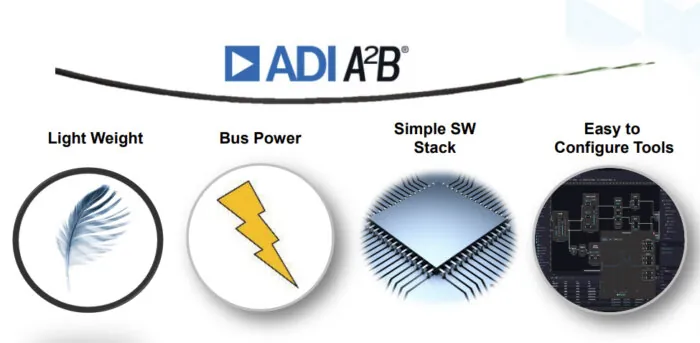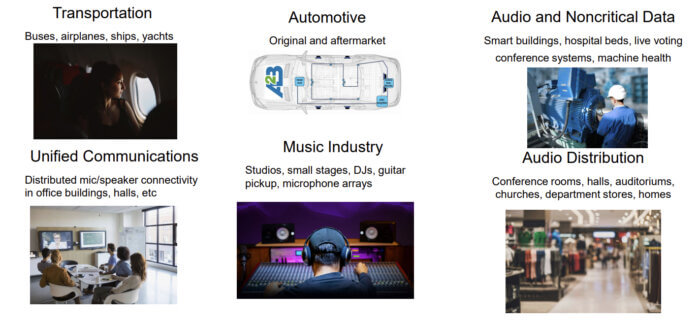In our modern world — where technology enables convenience — achieving seamless, high-quality audio with low latency will enhance live audio and conferencing applications. Analog Devices has developed a solution: A2B technology, which delivers synchronous, multichannel audio over a single twisted pair cable. From live music performances to state-of-the-art conference rooms, A2B is suitable for various applications due to its unique capabilities.
What is A2B? A2B is a two-wire serial bus technology whose appeal lies in its ability to transmit multiple synchronized, low-latency audio channels with exceptional fidelity. Synchronization — achieved with less than 50 microseconds of latency — is a game-changer for applications that require real-time audio processing, such as beamforming and noise suppression. With bidirectional data transfer at 50 Mbps bandwidth, A2B technology enables advanced signal processing techniques that would be impossible with unsynchronized audio streams.
Contents
Live Audio Applications: Unleashing the Power of Precision
In live audio scenarios, where every millisecond counts, A2B’s low latency shines through. Typical latency requirements for live audio applications can range from eight milliseconds round trip to even lower values, depending on the specific application. With A2B’s fixed latency for audio data — regardless of which node it originates on and how many nodes it is routed to — the audio bus can accommodate even the most demanding audio applications without compromising the user experience.
Compared to other audio-over-IP solutions — like Audinate’s Dante or AVB — A2B boasts a significantly lower latency, given its tailor-made hardwired audio product design. Plus, A2B’s synchronized nature sets the technology apart, enabling advanced signal processing techniques that would be impossible with unsynchronized audio streams. This feature is crucial for spatial filtering and noise cancellation, making it ideal for conferencing and other live audio applications like concerts, events and broadcast setups, where real-time processing is essential.
Other key A2B advantages for live audio include:
- Scalability: A2B supports multiple nodes, allowing engineers to build complex audio networks without compromising performance.
- Quality of Service: With built-in QoS mechanisms, A2B prioritizes critical audio data, maintaining high fidelity throughout the transmission.
- Cost: While A2B is inexpensive, it’s not as low-cost as simple analog audio. In addition, A2B offers many more capabilities than analog audio.
- Configurability: A2B’s configurability empowers engineers to tailor audio systems according to specific application needs, whether optimizing audio routing, implementing advanced audio processing or managing complex audio configurations.
A2B technology also simplifies the design and implementation of microphone nodes, making it well suited for live audio applications that require multiple microphones. A mid-point A2B microphone node can be realized with minimal components, including the A2B transceiver, microphone elements and a few discrete components, supporting up to four PDM MEMS microphones, with the option to extend to eight microphones by adding the ADAU7118 chip. GPIO can be used for input/output functions like a mute button, and PWM is supported for LED indicators.
A2B Networking Advantages

Conference Room Audio: Simplicity and Scalability
A2B’s unique capabilities make it an excellent choice for delivering high-quality and flexible audio systems in conference room settings. One of the key advantages is the ease of installation and system simplicity. The minimalistic hardware requirements consist of an A2B chip and a single twisted pair of wires to connect to other A2B chips, making the setup straightforward.
A2B technology’s low and deterministic latency enables high-performance AEC (acoustic noise cancellation), beamforming and noise suppression algorithms.
Compared to ethernet alternatives, which often require expensive networking equipment and dedicated hardware, A2B’s cost-effectiveness is a significant advantage. The communication infrastructure consists of an inexpensive chip and an unshielded twisted pair cable. Consequently, A2B enables substantial savings in installation, cable and equipment costs — more than $1,000 for a typical conference room — and a 25% reduction in installation time.
While A2B’s scalability may be limited compared to Dante, with a maximum of 16 nodes and 32 audio channels, it still offers ample flexibility for many conference room applications. For moderately sized conference rooms, 32 channels should more than suffice, but massively large conferencing spaces may require the more extensive scalability Dante offers.
Innovative Applications: A Recent A2B Project
One compelling use case for A2B is a recent client project, where we used A2B audio to transmit data from a device’s multiple microphones (between 8 and 10) to a computer for processing while ensuring low latency and high audio quality.
The project demanded a really light cable to connect to the device. Plus, lugging separate power supplies for everything or a bunch of heavy audio cables is inconvenient. Using A2B, our team could gather data from the connected audio device, send it to a computer for processing and then direct output audio back to the receiving end, minimizing latency concerns.
This project never saw signal degradation — no matter how long the cabling is — and engineers can throw it on a USB cable instead of using the dedicated twisted pair, which still seems to work well.
This unique application highlights A2B’s versatility, demonstrating its suitability for innovative audio solutions beyond traditional conferencing setups.
The Next Generation: Extending the Reach of A2B Technology
Analog Devices has recently introduced a new generation of A2B chips, significantly enhancing A2B technology. One of the most notable improvements is the extended range capabilities of the AD2437 chip. The AD2437 offers an extended internode (30 meters) and overall network length (300 m) across CAT and XLR cables with up to 50W bus power when daisy-chained. This substantial increase from the previous generation opens up new possibilities for large-scale deployments and complex audio systems.
Designed explicitly for nonautomotive applications, AD2437 addresses the growing demand for cost-effective edge connectivity solutions. In addition to the extended range, the new AD2437 chip offers several other notable features:
- A2B Plug-and-Play (PnP) Software Stack to ensure real-time interoperability between devices from single and multiple vendors.
- Maximum number of nodes increased to 16.
- 51 channels of 16-bit audio / 32 channels of 24-bit audio.
- SPI over distance.
- Simple I2S, TDM, PDM, I2C, SPI, GPIO interface extension.
- A2B self-boot feature.
- I2S/TDM data crossbar switch.
- Improved TDM pin flexibility (Rx vs. Tx).
- I2C Fast Mode+ (1Mbps).
- PWM control for LEDs.
With these enhancements, the new generation of A2B chips reinforces the technology’s position as a compelling choice for live audio, conference room applications and beyond, offering uncompromising performance and unparalleled flexibility in a compact, cost-effective package.
Examples of Applications Enabled by A2B

A2B Technology: Enabling the Future of Audio
The versatility of A2B technology has enabled its adoption across diverse industries and applications. In the automotive sector, A2B is utilized in buses, airplanes, ships and yachts for audio distribution and communication systems. The music industry also embraces A2B for studios, small stages, DJ setups, guitar pickups and microphone arrays. Unified communications solutions leverage A2B for distributed microphone and speaker connectivity in office buildings and halls. Additionally, A2B is finding applications in smart homes and buildings, hospital beds, live voting conference systems and machine health monitoring, where audio and noncritical data transmission is required.
As the demand for high-quality, low-latency audio solutions continues to grow, A2B’s unique combination of synchronized, multichannel audio transmission, ease of installation and cost-effectiveness offers a compelling alternative to traditional analog systems and other audio networking solutions. With engineers constantly finding innovative new ways to leverage its capabilities, A2B technology stands poised to revolutionize the way we approach audio.
Cardinal Peak is an A2B Design Partner
As an ADI Alliance design partner, Cardinal Peak has a wealth of experience with Analog Devices (ADI) components and software, particularly using A2B, SHARC, Catalina, Navassa and SigmaStudio. While we have used ADI parts in a variety of applications, we most commonly use these components in our networked audio designs where low latency is a must, such as in automotive audio, pro audio and teleconferencing applications.
With our extensive experience and expertise across industries, we can help bring your A2B solutions to life. Our team of experts looks forward to discussing your project requirements — connect with us today!
